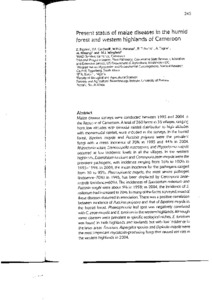| dc.contributor.author | Ngoko, Z. |
| dc.contributor.author | Cardwell, K.F. |
| dc.contributor.author | Marasas, W.F.O. |
| dc.contributor.author | Tchamo, P |
| dc.contributor.author | Tagne, A. |
| dc.contributor.author | Mwangi, M |
| dc.contributor.author | Wingfield, M.J. |
| dc.date.accessioned | 2019-12-04T11:18:12Z |
| dc.date.available | 2019-12-04T11:18:12Z |
| dc.date.issued | 2007 |
| dc.identifier.citation | Ngoko, Z., Cardwell, K.F., Marasas, W.F., Tchamo, P., Tagne, A., Mwangi, M. & Wingfield, M.J. (2007). Present status of maize diseases in the humid forest and western highlands of Cameroon, Demand-driven technologies for sustainable maize production in West and Central Africa: Proceedings of the fifth Biennial West and Central Africa Regional Maize Workshop, (p. 243-256 ), Cotonou, 3-6 May, 2005. Ibadan: IITA. |
| dc.identifier.uri | https://hdl.handle.net/20.500.12478/3102 |
| dc.description.abstract | Maize disease surveys were conducted between 1995 and 2004 inthe Republic of Cameroon. A total of 260 farms in 36 villages, ranging from low altitudes with bimodal rainfall distribution to high altitudes with monomodal rainfall, were included in the surveys. ln the humidforest, Bipolaris maydis and Puccinio polysora were the prevalent fungi with a mean incidence of 70% in 1995 and 44% in 2004. Rhizoctonia solani, Stenocarpella mocrospora, and Physodermo maydisoccurred at low incidence levels in all the villages. In the western highlands, Exserohilum turcicum and Cercospora zeae-maydis were the prevalent pathogens, with incidence ranging from 16% to 100% in 1995-1998. In 2004, the mean incidence for the pathogens ranged from 30 to 95%. Phaeosphaeria maydis, the most severe pathogen (incidence=70%) in 1995, has been displaced by Cercospora zeae-maydis (incidence=60%). The incidences of sporisorium reilianum and Puccinia sorghi were about 5% in 1998; in 2004, the incidence of S.reilianum had increase d to 20%. In many of the farms surveyed, most of these diseases occurred in association. There was a positive correlation between incidence of Puccinia polysora and that of Bipolaris maydis in the humid forest. Phaeosphaeria leaf spot vvas negatively correlated with C. zeae-maydis and E. turcicum in the western highlands. Although some diseases were prevalent in specific ecological niches, E. turcicum was found in both highlands and lowlands but with low incidence in the latter areas. Fusarium, Aspergillus species and Diplodia maydis were the most important mycotoxin-producing fungi that caused ear rots in the western highlands in 2004. |
| dc.description.abstract | Des enouetes sur les maladies du mais orrt 6t6 conduites entre 1995et 2004 en rdpublique du Cameroun. Au total 260.champs dans 36villages de zones ir basse altitude et de pluviometrie bimodale i deszones de haute altitude b pluviometrie monomodale sont inclus dansles enouetes. Dans les zones de for6t humides, Bipoloris moydis etPuccinio polysoro 6taient les champignons les plus courants avec Uneincidence moyenne de 70 et 44010 en 1995 et 2004 respectivement.Rhizoctonia solani, Stenocarpello mocrosporo, et Physoderma moydiSont et6 enregistr6s dans tous les villages avec un faible taux d'incidence.Dans les montagnes i l'ouest, Exserohilum turcicum el Cercosporo zeoe-moydrs €taient les pathogdnes les plus courants, avec une incidencevariant de 1 6 a 1 00 o/o en 1 995-1998. En 2004, l'incidence moyenneenregistr6e variait de 30 A 95olo pour les pathogenes. Phoeosphoeriomoydig la pathogdne le plus s6vdre (incidence=700/o) en 1995, a eteremplac6e par Cercosporo zeoe-n1ayd is (lncidence=600/o). L'incidencede sporborium reilianum et de Puccinia sorghi6tait de pris 50/o en 1 998.En 2OO4l'incidence de Sporisorium reilianum 6tait de 2o0lo. La plupartde ces maladies surviennent en association dans plusieurs des champsenqu€t6s. ll y avait une correlation positive des incidences entre Pucciniopolltsoro et Biooloris movdis dans la for6t humide. Phoeosphaerio.tache des feuilles, etait n6gativement corr6l6 i C. zeoe-maydis et E.turcicum dans les montagnes de I'ouest. Bien que certaines maladiesetaient sp6cifiques i leurs niches 6cologiques, E. turcicum a 6t6 trouv6aussi bien dans les montagnes que sur les plateaux, mais avec unefaible incidence sur les plateaux. Les espEces Fusarium, Aspergillus etDiptodia moydis 6taient les champignons les plus importants produisantdes mycotoxines qui provoquent des pourritures de racines dans lesmontagnes de l'ouest en 2004. |
| dc.language.iso | en |
| dc.language.iso | fr |
| dc.subject | Maize Diseases |
| dc.subject | Bipolaris Maydis |
| dc.subject | Humid Forest |
| dc.subject | Pathogen |
| dc.title | Present status of maize diseases in the humid forest and western highlands of Cameroon |
| dc.type | Conference Paper |
| dc.description.version | Peer Review |
| cg.contributor.affiliation | Institute of Agricultural Research for Development, Cameroon |
| cg.contributor.affiliation | United States Department of Agriculture |
| cg.contributor.affiliation | Medical Research Council, South Africa |
| cg.contributor.affiliation | International Institute of Tropical Agriculture |
| cg.contributor.affiliation | University of Pretoria |
| cg.coverage.region | Africa |
| cg.coverage.region | Central Africa |
| cg.coverage.country | Cameroon |
| cg.authorship.types | CGIAR and developing country institute |
| cg.iitasubject | Plant Diseases |
| cg.iitasubject | Meteorology And Climatology |
| cg.iitasubject | Pests Of Plants |
| cg.iitasubject | Forestry |
| cg.accessibilitystatus | Limited Access |
| local.dspaceid | 94568 |

